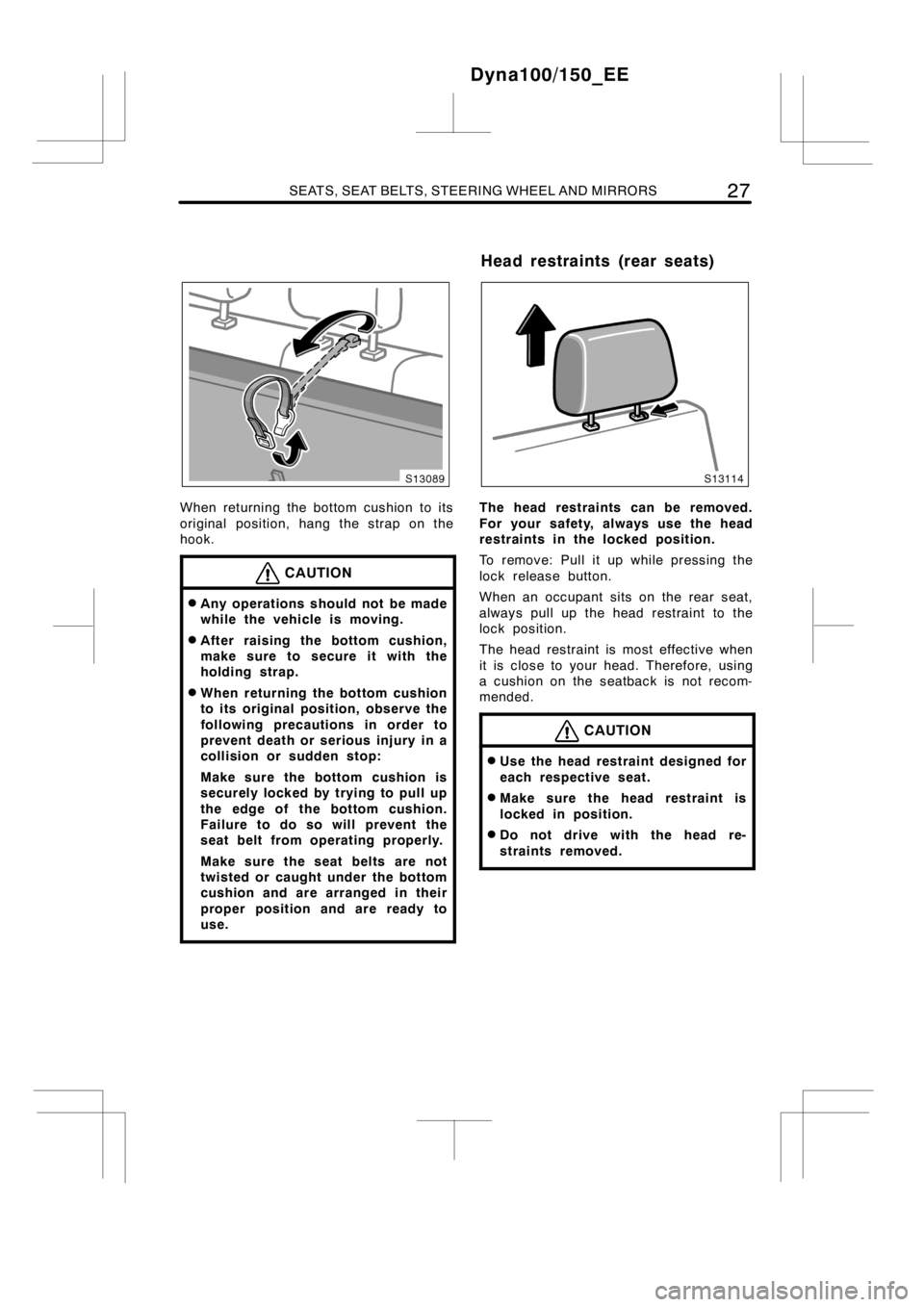Page 5 of 240

v
Table of contents
1 OPERATION OF INSTRUMENTS AND CONTROLSPage
1 Overview of instruments and controls
1 .......................
2 Keys and Doors11 ......................................
3 Seats, Seat belts, Steering wheel and Mirrors23 ...............
4 Lights and Wipers61 .....................................
5 Gauges, Meters and Service reminder indicators67 .............
6 Engine (ignition) switch, Transmission and Parking brake79 ......
7 Audio system83 .........................................
8 Air conditioning system91 .................................
9 Other equipment107 .....................................
2 INFORMATION BEFORE DRIVING YOUR TOYOTA 115........
3 STARTING AND DRIVING 131...............................
4 IN CASE OF AN EMERGENCY 149..........................
5 CORROSION PREVENTION AND APPEARANCE CARE 177...
6 MAINTENANCE REQUIREMENTS 183.......................
7DO−IT−YOURSELF MAINTENANCE
1 Introduction187 .........................................
2 Engine and Chassis195 ..................................
3 Electrical components207 .................................
8 SPECIFICATIONS 219......................................
9 INDEX 229................................................
Dyna100/150_EE
Page 9 of 240
OVERVIEW OF INSTRUMENTS AND CONTROLS3
1. Headlight and turn signal switches
2. Wiper and washer switches
3. DPF (Diesel Particulate Filter) system
manual regeneration switch
(If equipped)
4. Emergency flasher switch
5. Air conditioning controls
6. Audio system
7. Rear fog light switch8. Auxiliary box
9. Cup holder
10. Headlight beam level control dial
11 . A s h t r a y
12. Cigarette lighter
13. Heater idle up switch
14. Engine switch
15. Tilt and telescopic steering lock
release lever
Dyna100/150_EE
Page 11 of 240
OVERVIEW OF INSTRUMENTS AND CONTROLS5
1. Card holder
2. Air conditioning controls
3. Emergency flasher switch
4. Heater idle up switch
5. Headlight and turn signal switches
6. Wiper and washer switches
7. Engine switch
8. Tilt and telescopic steering lock
release lever9. Cigarette lighter
10. Headlight beam level control dial
11 . A s h t r a y
12. Auxiliary box
13. Cup holder
14. Rear fog light switch
15. DPF (Diesel Particulate Filter) system
manual regeneration switch
(If equipped)
16. Audio system
Dyna100/150_EE
Page 29 of 240
SEATS, SEAT BELTS, STEERING WHEEL AND MIRRORS23
Section 1−3
OPERATION OF INSTRUMENTS AND
CONTROLS
Seats, Seat belts, Steering wheel and Mirrors
DSeats 24..............................................
DDriver’s seat 24.......................................
DFolding up rear seat 26.................................
DHead restraints 27.....................................
DSeat belts 28..........................................
DSRS driver airbag 38...................................
DChild restraint 44......................................
DTilt and telescopic steering wheel 58....................
DOutside rear view mirrors 59............................
Dyna100/150_EE
Page 30 of 240

24SEATS, SEAT BELTS, STEERING WHEEL AND MIRRORS
While the vehicle is being driven, all ve-
hicle occupants should have the seatback
upright, sit well back in the seat and prop-
erly wear the seat belts provided.
CAUTION
DDo not drive the vehicle unless the
occupants are properly seated. Do
not allow any occupants to sit on
top of a folded−down seatback, or
in the luggage compartment or car-
go area. If the occupants are im-
properly seated or restrained by
seat belts, death or serious injury
could result in the event of emer-
gency braking, sudden swerving or
an accident.
DDuring driving, do not allow any
passengers to stand up or move
around between seats. Otherwise,
death or serious injuries can occur
in the event of emergency braking,
sudden swerving or an accident.
Adjust the driver ’s seat so that the foot
pedals, steering wheel and instrument
panel controls are within easy reach of
the driver.
CAUTION
DDo not adjust the seat while the
vehicle is moving as the seat may
unexpectedly move and cause the
driver to lose control of the vehicle.
DWhen adjusting the seat, be careful
that the seat does not hit a lug-
gage.
DAfter adjusting the seat position, re-
lease the lever and try sliding the
seat forward and backward to make
sure it is locked in position.
DMake sure the seatback is securely
locked by pushing forward and rear-
ward on the top of the seatback.
Failure to do so will prevent the
seat belt from operating properly.
DDo not put objects under the driv-
er ’s seat. Otherwise, the objects
may interfere with the seat−lock
mechanism or unexpectedly push
up the seat position adjusting lever
and the seat may suddenly move,
causing the driver to lose control of
the vehicle.
DWhile adjusting the seat, do not put
your hands under the seat or near
the moving parts. Otherwise, you
may catch and injure your hands or
fingers.
Dyna100/150_EE
SeatsDriver’s seat—
—Seat adjustment precautions
Page 31 of 240
SEATS, SEAT BELTS, STEERING WHEEL AND MIRRORS25
1. SEAT POSITION ADJUSTING LEVER
Pull the lever up. Then slide the seat
to the desired position with slight body
pressure and release the lever.
2. SEATBACK ANGLE ADJUSTING
LEVER
Lean forward and pull the lever up.
Then lean back to the desired angle
and release the lever.
CAUTION
Avoid reclining the seatback any
more than needed. The seat belt pro-
vides maximum protection in a frontal
or rear collision when the driver is
sitting up straight and well back in
the seat. If you are reclined, the lap
belt may slide past your hips and
apply restraint forces directly to the
abdomen or your neck may contact
the shoulder belt. In the event of a
frontal collision, the more theseat is
reclined, the greater the risk of death
or serious injury.
3. SEAT LUMBAR SUPPORT
ADJUSTING LEVER
Pull the lever forward.
Repeat this until you have a comfortable
support.
Dyna100/150_EE
—Adjusting driver’s seat
Page 32 of 240
26SEATS, SEAT BELTS, STEERING WHEEL AND MIRRORS
1. Unlock the seat leg. Swing up the
bottom cushion.2. Hook the strap.
Dyna100/150_EE
Folding up rear seat
Page 33 of 240

SEATS, SEAT BELTS, STEERING WHEEL AND MIRRORS27
When returning the bottom cushion to its
original position, hang the strap on the
hook.
CAUTION
DAny operations should not be made
while the vehicle is moving.
DAfter raising the bottom cushion,
make sure to secure it with the
holding strap.
DWhen returning the bottom cushion
to its original position, observe the
following precautions in order to
prevent death or serious injury in a
collision or sudden stop:
Make sure the bottom cushion is
securely locked by trying to pull up
the edge of the bottom cushion.
Failure to do so will prevent the
seat belt from operating properly.
Make sure the seat belts are not
twisted or caught under the bottom
cushion and are arranged in their
proper position and are ready to
use.
The head restraints can be removed.
For your safety, always use the head
restraints in the locked position.
To remove: Pull it up while pressing the
lock release button.
When an occupant sits on the rear seat,
always pull up the head restraint to the
lock position.
The head restraint is most effective when
it is close to your head. Therefore, using
a cushion on the seatback is not recom-
mended.
CAUTION
DUse the head restraint designed for
each respective seat.
DMake sure the head restraint is
locked in position.
DDo not drive with the head re-
straints removed.
Dyna100/150_EE
Head restraints (rear seats)